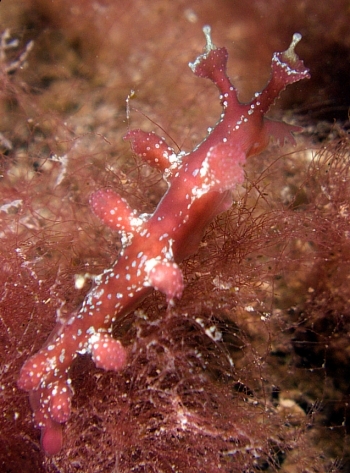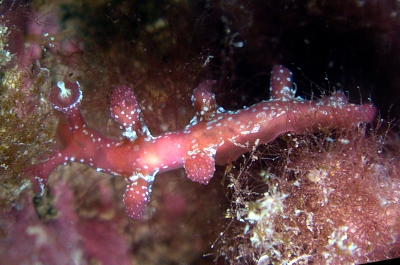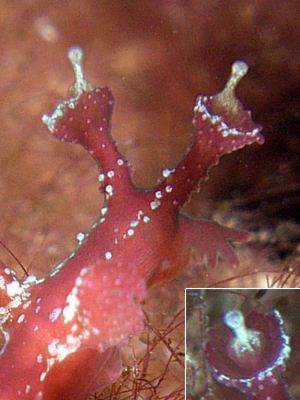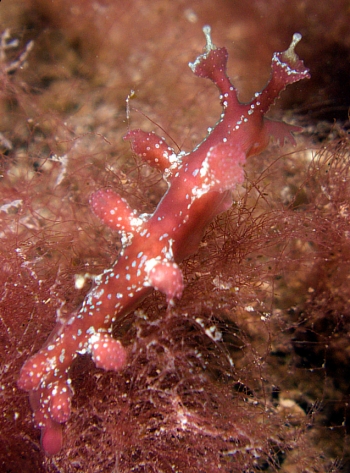
Hancockia uncinata
(Hesse, 1872)
Order: NUDIBRANCHIA
Suborder: DENDRONOTINA
Family: Hancockiidae
DISTRIBUTION
Known from the NE Atlantic [western Meditteranean, Bay of Biscay, sthn England, Scotland, NW Ireland].
PHOTO
Sound of Mull, 17 m, Scotland, NE Atlantic, 7 September, rocky reef. Length: 15 mm. Photographer: Jim Anderson.
The body is translucent pink or greenish with opaque whte spots scattered over the dorsal surface and outlining the edge of the dorsum and the edge of the rhinophore sheaths. The cerata are similarly coloured and also have white spots, those in the bottom half apparently are white pigment spots on the skin, while those in the upper half of each ceras are pustules at the tip of branches of the digestive gland ducts. Eliot (1910) reported that these were cnidosacs containing stinging nematocysts as found in many aeolids. The cerata are large and flattened and are attached at the upper edge of the mantle, on each side, in opposite pairs. There can be up to nine pairs of cerata depending on the length of the animal.
Each rhinophore is enclosed in an inverted cone-like sheath raised on a thick elongate stalk. The rhinophores are swollen structures attached to the base of each sheath and divided into vertical lamellae. Arising from the centre of each rhinophore is an elongate stalk with a large rounded tip. There is a flattened oral lobe on each side of the mouth with three or four papillae along the edge.
Picton & Morrow (1994) report that the species feeds on a small hydroid Clytia haemisphaerica which often grows over other hydroids and algae. Hancockia uncinata can reach about 14 mm in length.
- Eliot, C.N.E. (1910) A monograph of the British nudibranchiate Mollusca with figures of the species. pt. VIII (supplementary). Figures by the late Joshua Alder and the late Albany Hancock, and others: 1-198, Pls. 1-8. Ray Society, London.
- Picton, B. E. and Morrow, C. C. (1994) A Field Guide to the Nudibranchs of the British Isles. London, Immel Publishing Ltd. 143pp.
- Thompson, T.E. & Brown, G.H. (1984) Biology of Opisthobranch Molluscs, Vol 2. 229pp. 41 Pls., Ray Society: London
Rudman, W.B., 2008 (September 11) Hancockia uncinata (Hesse, 1872). [In] Sea Slug Forum. Australian Museum, Sydney. Available from http://www.seaslugforum.net/find/hancunci
Related messages
Hancockia uncinata - first record from Scotland
September 12, 2008
From: Jim Anderson

Bill,
This is a first sighting of this species in Scotland.
It was spotted by my buddy, Iain Graham, during a dive in the Sound of Mull on Sunday. Water temperature was 14 deg C.
Locality: Sound of Mull, 17 m, Scotland, NE Atlantic, 7 September, rocky reef. Length: 15 mm. Photographer: Jim Anderson.
Kind regards,
Jim A
jander4454@gmail.com



Dear Jim,
Thanks for the record of this rarely reported species. It is a species I have wanted to add to the Forum but have been unable to find photos of. I have included close-ups of your photos as they show the details of the rhinophores, the hand-like oral lobes and the branching of the digestive gland in the cerata. It looks as though each white spot on the upper half of each ceras represents the tip of a digestive gland branch. Eliot (1910) reported that this species has cnidosacs, containing stinging nematocysts as in many aeolids, at the tip of digestive gland branches, so these upper whitish pustules may be these structures described by Eliot..
-
Eliot, C.N.E. (1910) A monograph of the British nudibranchiate Mollusca with figures of the specics. pt. VIII (supplementary). Figures by the late Joshua Alder and the late Albany Hancock, and others: 1-198, Pls. 1-8. Ray Society, London.
Best wishes,
Bill Rudman
